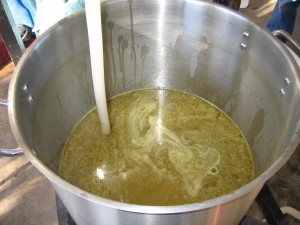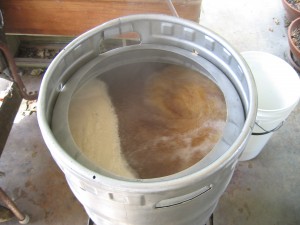This article is part of a series on barleywine.
Once you’ve collected your wort, it’s time to boil. In most cases, brewing an all-grain barleywine involves an extended boil. When making an extract barleywine, or an all-grain barleywine from first wort, an extended boil may not be needed. Barleywines are amply hopped, so the amount of hop debris that will be generated should be considered when choosing a hopping schedule.
Boil Duration
Once the wort is in your kettle, you may not know how long it will take to boil it down to your target post-boil wort volume. If you’ve previously recorded your evaporation rate, you can estimate your boil time from this. If not, you can see how much volume you lose after an hour of boiling and base your estimate on that. Knowing the estimated length of your boil will let you time the addition of your bittering hops. For example, if you had 8 gallons to boil down to 5, you would have 3 gallons of water to evaporate. If you measured your boil rate at 1.25 gallons/hour in the first hour, you would know that your boil should last about (3 (gallons)/1.25 (gal/hr)=) 2.4 hours. If your first hop addition came with 60 minutes left in the boil, you would add them after boiling for 1.4 hours (1 hour and (60 (min/hr)*0.4 (hrs) =) 24 minutes). If your kettle isn’t calibrated — for example, by having a dipstick that measures volume — you should calibrate it before brewing your barleywine.
For homebrewers, an evaporation rate around 1 gallon per hour (~4 L/hr) is common. For longer boils, turning up the heat and evaporating water at a greater rate is possible, to a point. However, be aware that trying to boil the wort too hard can result in scorching. Maintain a vigorous, rolling boil and the time will pass quickly enough. Stir frequently.
At the beginning of the boil, you may wonder if you are on track to hit your target OG. To estimate this, use the concentration and volume formula:
C1V1 = C2V2
where C is concentration and V is volume of the pre-boil wort (subscript 1) and post-boil wort (subscript 2).
For example, lets say you have 8 gallons of wort at SG 1.060. If you boil it down to 5 gallons, you’ll have:
8(60) = 5(x), x = 96 (so, the OG at 5 gallons would be 1.096)
This estimate may be a little high as soluble proteins will contribute to the pre-boil specific gravity. However, these proteins will coagulate and be insoluble by the end of the boil. As such, expect your OG to be a couple points lower than this equation predicts.
During an extended boil, you can clean and sanitize any equipment you’ll need later or you can work on brewing a second beer, if you’ve left any sugars behind in the grain bed.
Hop Varieties
Barleywines are fairly heavily hopped. However, due to their high original gravities and full body, they end up tasting more balanced than double IPAs. When choosing hop varieties, you can think of a barleywine as very big pale ale. The English hops that work well in bitters, English pale ales and ESBs will also do well in an English barleywine. Fuggles and Kent Golding, for example, will work well as finishing hops. Likewise, American hops that are typically featured in American pale ales and IPAs will do well in an American barleywine. Cascade, any of the other “C” hops, plus Amarillo are all good choices for late hops. You can also blend some of the higher cohumulone American hops with neutral, low-cohumulone to keep the hop character from getting too “sharp” or “aggressive.” You don’t have to choose all low cohumulone hops, however. Especially in an American barleywine, a little “bite” from the cohumulone can give the beer a bit of and edge that keeps it from being too smooth.
Hop Schedule

Brewing a barleywine involves a lot of hops. Get the most of them to minimize the amount of wort-stealing hop debris in the kettle.
You can hop a barleywine using any schedule you want. Many homebrewed barleywines follow the usual trio of bittering, flavor and aroma hops, often added with roughly 60, 15 and 0 minutes left in the boil. Because you’ll use a lot of hops and the wort is at a very high specific gravity, I like to keep the amount of plant material in the boil to a minimum as long as I meet my goals of bittering, flavor and aroma. For this reason, I like the “bookends” methods for hopping a barleywine. Add your bittering hops with 60-90 minutes left in the boil, to get as much hop utilization as is practically possible from them. Use the highest alpha hops you can find, presuming the variety is acceptable for your beer. Then, add all the flavor and aroma hops at knockout to get all the possible hop oils from them. In a barleywine, I know I am going to be losing some wort to the hop debris. This way, I lose as little as possible.
Hop utilization decreases with increasing wort density. So, you’ll need to add more hops to a barleywine to reach the same level of bitterness you would yield in a pale ale. For an OG 1.090 barleywine, you’d need to add about 20% more hops to get the same bitterness as in an OG 1.050 pale ale. Many homebrew recipes calculators take wort gravity into consideration automatically.
Irish Moss
Irish moss is, of course, a kettle fining agent used to help clarify beer by sedimenting proteins during the boil. The negatively charged flakes of Irish moss attract positively charged proteins during the boil, then the Irish moss settles to the bottom of the kettle when the boil is over. In a normal-strength homebrew, an effective rate of addition is 1 teaspoon per 5 gallons. In a barleywine, the concentration of proteins in the boil is higher and adding more Irish moss may help. How much more to add is a good question, however. I usually just “eyeball” the wort near the end of the boil and estimate how much more break material I have in suspension, compared to a regular-strength beer, then add proportionally more Irish moss.
This series of articles will resume after Christmas.
—
Related articles
How Much Wort Should Extract Brewers Boil?


Speak Your Mind